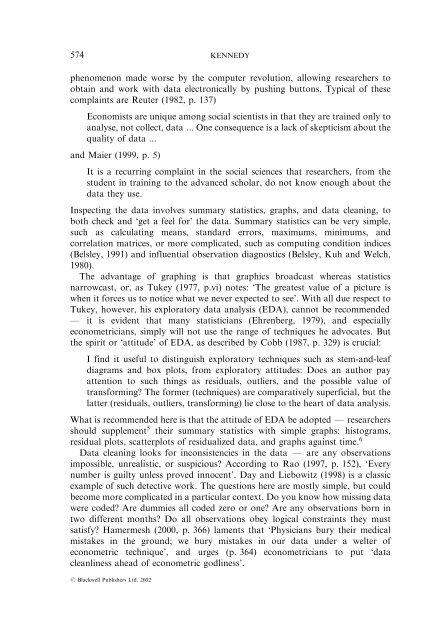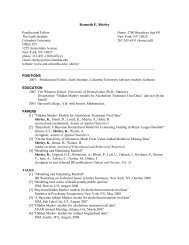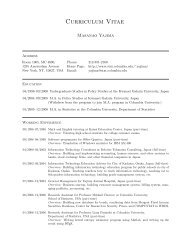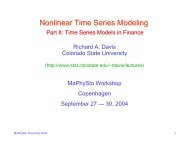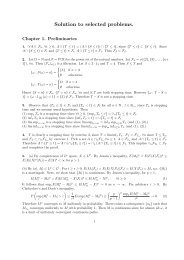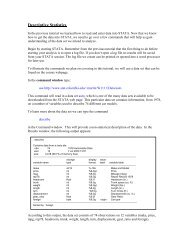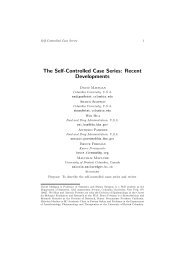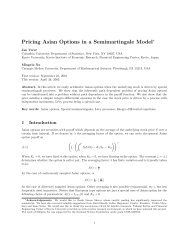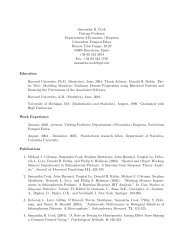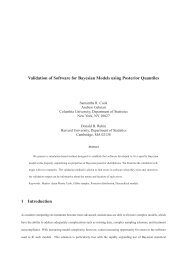sinning in the basement: what are the rules? the ten commandments ...
sinning in the basement: what are the rules? the ten commandments ...
sinning in the basement: what are the rules? the ten commandments ...
You also want an ePaper? Increase the reach of your titles
YUMPU automatically turns print PDFs into web optimized ePapers that Google loves.
574 KENNEDY<br />
phenomenon made worse by <strong>the</strong> computer revolution, allow<strong>in</strong>g researchers to<br />
obta<strong>in</strong> and work with data electronically by push<strong>in</strong>g buttons. Typical of <strong>the</strong>se<br />
compla<strong>in</strong>ts <strong>are</strong> Reuter (1982, p. 137)<br />
Economists <strong>are</strong> unique among social scientists <strong>in</strong> that <strong>the</strong>y <strong>are</strong> tra<strong>in</strong>ed only to<br />
analyse, not collect, data ... One consequence is a lack of skepticism about <strong>the</strong><br />
quality of data ...<br />
and Maier (1999, p. 5)<br />
It is a recurr<strong>in</strong>g compla<strong>in</strong>t <strong>in</strong> <strong>the</strong> social sciences that researchers, from <strong>the</strong><br />
student <strong>in</strong> tra<strong>in</strong><strong>in</strong>g to <strong>the</strong> advanced scholar, do not know enough about <strong>the</strong><br />
data <strong>the</strong>y use.<br />
Inspect<strong>in</strong>g <strong>the</strong> data <strong>in</strong>volves summary statistics, graphs, and data clean<strong>in</strong>g, to<br />
both check and ‘get a feel for’ <strong>the</strong> data. Summary statistics can be very simple,<br />
such as calculat<strong>in</strong>g means, standard errors, maximums, m<strong>in</strong>imums, and<br />
correlation matrices, or more complicated, such as comput<strong>in</strong>g condition <strong>in</strong>dices<br />
(Belsley, 1991) and <strong>in</strong>fluential observation diagnostics (Belsley, Kuh and Welch,<br />
1980).<br />
The advantage of graph<strong>in</strong>g is that graphics broadcast whereas statistics<br />
narrowcast, or, as Tukey (1977, p.vi) notes: ‘The greatest value of a picture is<br />
when it forces us to notice <strong>what</strong> we never expected to see’. With all due respect to<br />
Tukey, however, his exploratory data analysis (EDA), cannot be recommended<br />
— it is evident that many statisticians (Ehrenberg, 1979), and especially<br />
econometricians, simply will not use <strong>the</strong> range of techniques he advocates. But<br />
<strong>the</strong> spirit or ‘attitude’ of EDA, as described by Cobb (1987, p. 329) is crucial:<br />
I f<strong>in</strong>d it useful to dist<strong>in</strong>guish exploratory techniques such as stem-and-leaf<br />
diagrams and box plots, from exploratory attitudes: Does an author pay<br />
at<strong>ten</strong>tion to such th<strong>in</strong>gs as residuals, outliers, and <strong>the</strong> possible value of<br />
transform<strong>in</strong>g? The former (techniques) <strong>are</strong> comparatively superficial, but <strong>the</strong><br />
latter (residuals, outliers, transform<strong>in</strong>g) lie close to <strong>the</strong> heart of data analysis.<br />
What is recommended here is that <strong>the</strong> attitude of EDA be adopted — researchers<br />
should supplement 5 <strong>the</strong>ir summary statistics with simple graphs: histograms,<br />
residual plots, scatterplots of residualized data, and graphs aga<strong>in</strong>st time. 6<br />
Data clean<strong>in</strong>g looks for <strong>in</strong>consis<strong>ten</strong>cies <strong>in</strong> <strong>the</strong> data — <strong>are</strong> any observations<br />
impossible, unrealistic, or suspicious? Accord<strong>in</strong>g to Rao (1997, p. 152), ‘Every<br />
number is guilty unless proved <strong>in</strong>nocent’. Day and Liebowitz (1998) is a classic<br />
example of such detective work. The questions here <strong>are</strong> mostly simple, but could<br />
become more complicated <strong>in</strong> a particular context. Do you know how miss<strong>in</strong>g data<br />
were coded? Are dummies all coded zero or one? Are any observations born <strong>in</strong><br />
two different months? Do all observations obey logical constra<strong>in</strong>ts <strong>the</strong>y must<br />
satisfy? Hamermesh (2000, p. 366) laments that ‘Physicians bury <strong>the</strong>ir medical<br />
mistakes <strong>in</strong> <strong>the</strong> ground; we bury mistakes <strong>in</strong> our data under a welter of<br />
econometric technique’, and urges (p. 364) econometricians to put ‘data<br />
cleanl<strong>in</strong>ess ahead of econometric godl<strong>in</strong>ess’.<br />
# Blackwell Publishers Ltd. 2002


